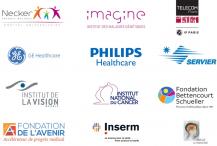Publish at
Presentation
IMAG2 is a unique rising project at Imagine Institute in Necker Hospital gathering skills of surgeons dedicated to mini-invasive approaches, biomedical engineers specialized in 3D modeling with MRI images and radiologists experts in nerve tractography. The aim of this multidisciplinary team is to improve preoperative planning of pediatric tumors and malformations, leading to a higher level of security, efficacy and less morbidity. This project focuses for now on pelvic tumors and malformations, but aims at a spread to all pediatric surgical specialties that are represented in Necker Hospital.
Primary goals:
- Segmentation and 3D modeling of tumors : Abdominal and pelvic and 3T MRI images will be used to develop segmentation models and build an executable file that will lead to semi-automatization of the process. This technology will be available for surgeons in routine to enhance the surgical strategy and will lead to the set up of a 3D radiologic database of patient with pediatric tumors and malformations.
- Tractography of the pelvis : 3T MRI images will be used to develop nerve tractography data, which will be associated to the results of 3D modeling. Computational analysis of images will be performed to optimize the representation of the pelvic nerves network for preoperative workup abdominal and pelvic tumors and malformations.
Secondary goal / Perspectives:
- Computer-assisted surgery through image overlay. Ongoing partnerships may allow us to inject our 3D patient specific models into laparoscopic and/or robotic devices in the operating room in order to perform image guided surgery.
Conclusion:
IMAG2 will combine the best aspects of imaging and minimally invasive techniques to create optimal hybrid approaches for improving surgery in pediatric oncology and malformations. Pre-operative 3D modeling and nerve tracking will allow surgeons to plan and perform optimal hybrid procedures that leverage computer assistance and robotic augmentation to reproduce tasks that human surgeons alone cannot perform and improve pediatric surgical care.
Image: Presacral Neurofibrona in 12 Years Old Girl With Associated Anatomical Modelling and Tractogram



